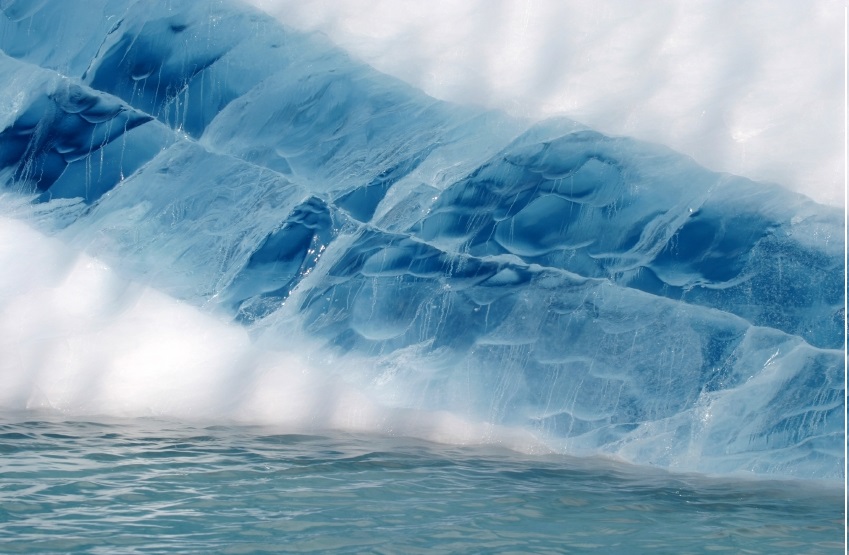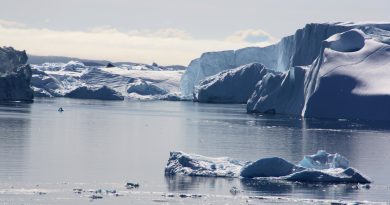Long-term warming inside Greenland’s ice sheet

In the mid-20th century, when Carl Benson was traveling Greenland gathering data he would use to write his Ph.D. thesis on the temperature, structure and composition of the hard-packed snow that covers that island, conditions deep beneath the surface were fairly consistent: white, firm, cold and dry.
“If you could imagine cutting a wall of Styrofoam, that’s what it was like,” said Benson, now a professor emeritus with the University of Alaska Fairbanks’ Geophysical Institute.
Six decades later, researchers who revisited several of Benson’s test sites on the Greenland ice sheet found something different.
Measurements taken in that 2013 expedition found temperatures below the surface had warmed by as much as 10 degrees Fahrenheit since Benson and his colleagues examined conditions in pits dug across Greenland in the 1950s, according to a study now online in the journal Geophysical Research Letters. Warming was “substantial” in the test sites located at elevations between 1,400 meters (4,593 feet) and 2,500 meters (8,202 feet), the study said.
Snowmelt
The new survey also found evidence of snowmelt — with ice layers formed by the refrozen water — at every site tested. That made for some tougher digging conditions than those that Benson encountered, said lead author Chris Polashenski, a research geophysicist at the U.S. Army Corps of Engineers Cold Regions Research and Engineering Laboratory.
“He just had a shovel, and we needed a pick-ax,” said Polashenski, who also teaches at Dartmouth.
Major changes since the 1950s were especially apparent at mid-altitude sites, according to the study.
At test sites at elevations of 1,700 meters (5,577 feet) or above, Benson and his team found little or no evidence of melt, Polashenski said. Findings were different in the new survey, he said.
“Here, we saw melt at every single site we went to,” he said.
Temperature data
The study focused on temperatures below the surface of the old, dry snow known as “firn” that covers much of interior Greenland. As Benson did in his 1952-55 surveys, the team led by Polashenski dug pits and inserted thermometers to record temperatures 10 meters (32.8 feet) down, at depths considered to be unaffected by the change in seasons.
The 2013 temperature survey was related to another study, recently published in Proceedings of the National Academy of Sciences, that examined the unusual 2012 melt over the entire Greenland ice-sheet surface. That study, led by a Dartmouth researcher, found that the 2012 melt event, like one that occurred in 1889, was the product of unusually warm conditions combined with heavy amounts of black carbon deposited on Greenland from large wildfires elsewhere in the world.
Snowmelt was likely responsible for the higher temperatures that Polashenski’s team found at depth, according to the new study.
Melted snow sends water percolating down into the surface of the ice sheet, and that meltwater carries latent heat. When the water is refrozen, the latent heat is released into the firn column, according to the study. The result was that at some of the sites surveyed in 2013, warming in the firn had been accelerated and was “appreciably faster” that even the relatively rapid warming of Greenland’s air temperatures, the study said. While some of the melt below the firn surface was attributable to the 2012 event, much of it was likely long-term, the study said.
Unlike the coastal areas in Greenland that are seeing rapid melt, the surveyed sites are too far inland to produce runoff that would contribute to sea-level rise — at least for now, Polashenski said. But meltwater from even such inland sites might make its way to Greenland’s coastline in coming years, he said.
“We’ve warmed the firn enough over the last 60 years that we’re looking at a situation in the not-too-distant future that it will be warm enough to cause runoff,” he said.
Multi-year expedition
For Benson, now 87 and a recipient in 2012 of a lifetime achievement award from UAF, the latest findings about temperature and icing were hardly out of the blue.
“I wasn’t surprised, considering the way the climate is changing,” he said. He was “thrilled,” he said, “to hook up with the younger people who were able to go back to the same sites and measure the temperatures at the same depths.”
Still, the news is a little depressing, he conceded. “I’m disappointed anytime ice melts,” he said.
More than temperature has changed since he conducted his pioneering studies in Greenland.
During the 1952-55 expedition, Benson was among a group of six people who spent two months each year preparing for the on-ice mission and then 120 days in interior Greenland. They traveled across the ice sheet on modified Weasels, World War II-era snow tractors built by Studebaker that were slower than the sophisticated snow vehicles used by modern researchers. Over the four years of the expedition, Benson’s group traveled about 1,100 miles.
The multi-year expedition — the first documented traverse of Greenland at such high latitudes — relied on supplies carried in by the scientists or provided by occasional air drops. There were no cell phones, no satellite phones, no GPS-guided navigational instruments and no manned research stations; the only communications with the outside world were messages sent by Morse code to the then-new Thule Air Base, Benson said.
“Every night, we told them where we were, and no broken legs, and all that,” he said.
Contact Yereth Rosen at yereth(at)alaskadispatch.com
Related stories from around the North:
Canada: Government in Canada’s eastern Arctic to issue permafrost guide to homeowners, CBC News
Finland: Walkers warned: Finland’s sea ice could be thinner than it looks, Yle News
Greenland: Soot, heat combined to create unusual melt on Greenland’s ice, CBC News
Russia: Melting permafrost eroding Siberian coasts, Deutsche Welle’s Iceblogger
Sweden: Weather deals double blow to Sweden’s timber industry, Radio Sweden
United States: Arctic sea ice sends mixed messages about how rapidly it’s melting, Alaska Dispatch



